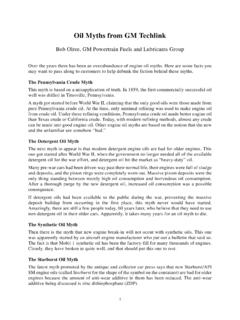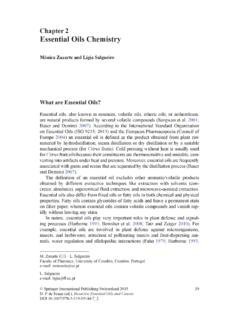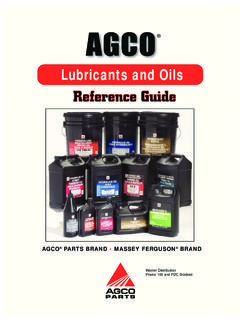Transcription of Oils and ZDDP - Nonlinear Technologies, Inc.
1 1 zddp and Older Automobile EnginesSteve Maas; Long Beach, CaliforniaThe ProblemAn article called Oil is Killing Our Engines by Keith Ansell( ) has been making the rounds of internetautomotive forums. There has been some discussion of it on the British Car Forum, which Ifrequent, as well. I m always a little concerned when I read such mildly hysterical articles bypeople who have no real expertise in the subject and are simply repeating what they haveheard. Invariably the story is much more complex, and, in my experience, such articlesregularly overstate or oversimplify their case. So, with a healthy skepticism, I decided to do alittle independent research. I don t claim to be an expert in lubrication; I m an electricalengineer.
2 But I do think I have considerably greater skill in evaluating and integratingtechnical information than most people commenting on this subject. Here is what I found. The question concerns the reduction of zinc dialkyldithiophosphate ( zddp ) in API-SM ratedmotor oils , the standard for oils used in gasoline passenger-car engines today. Theconcentration of zddp in such oils has varied through the years in response to the needs ofchanging engine technology. In 2004, however, the US government mandated 120,000 milelifetimes for catalytic converters, and since phosphorous contaminated them, the phosphorouscontent of oil had to be reduced. Thus, modern API-SM oils have reduced levels of zddp , toa greater or lesser degree. Zinc content is usually used as a measure of zddp content, althoughphosphorous is really the critical element.
3 Phosphorous levels are typically 75% to 90% of thezinc concentration. The zinc concentration is often given in parts per million by weight (PPM);1000 PPM is Maximum zinc content today is rarely more than (800 PPM),compared to approximately (1200 PPM) previously. Some modern oils haveconsiderably less. In general, however, this is not a dramatic reduction. The greatest concern is for camshaft wear in flat-tappet engines, especially those having hightappet pressure at the camshaft. Especially when they are new, the mating surfaces havemicroscopic high points that can interfere and cold weld under high pressure. These thenbreak loose, creating even more microscopic roughness, and the process continues untilmeasurable wear occurs.
4 By creating a sacrificial layer that coats these high points andprevents microscopic high-pressure regions that lead to galling, zddp prevents this processfrom occurring. Modern engines have redesigned lifters that minimize this so-called scuffingaction, so their need for zddp is much less. A central implication of the Oil is Killing Our Engines article is that the zddp concentration was recklessly reduced with no concern for the needs of older cars. This is justnot credible. In any technical field, concern for backward compatibility is absolutely in theforefront when such changes are made. Invariably, the goal is not simply to meet the newrequirements, but to do so without creating new problems. In this case, the goal was to extendcatalytic converter lifetime without affecting the huge number of older cars currently in do anything else would be absolutely lunatic.
5 2 For this reason, motor oils still have some amount of zddp . SM oils are subject to standardtests for scuff resistance, to make sure they are compatible with older engines. However, thevalidity of these tests in some cases has been questioned, as they are largely for ordinaryservice and may not apply to high-performance engines with stiffer valve springs, more lift,and generally higher tappet pressures. Typical forces are for the tests are 350 lb at the tappet;as this includes dynamic forces and lifter leverage, the valve-spring force may be less than halfof this value. Many high-performance engines operate at much higher pressures, and smallertappets have greater surface pressure for a given force. The many anecdotal reports of camshafts wearing out after less than 1000 miles have beencited as evidence of this problem.
6 Such stories are disturbing, but in reality they tell us nothingabout the purported problem. Lots of things can wear out a camshaft too fast; for example,tappets that are too loose in the block, poor initial lubrication ( , no or poor qualityassembly lube) low-quality tappets, or improper surface hardening by the manufacturer. If thishorrific wear is a direct result of low zddp , why don t all new camshafts wear similarly? Thisis a perfect example of something that looks like evidence of a problem, but really isn t. The possibility that bad manufacturing caused this reported camshaft failure must also betaken seriously. It s awfully easy for a manufacturer to screw up, then blame its failed parts onthe oil used by the customer. It is interesting that the evidence for this problem, in the Ansellarticle, came only from statements by engine-component manufacturers and makers of oils (especially hyper-expensive racing oils ) that conceivably could solve this purported would expect that research for such an article would have included independentindividuals with genuine expertise, such as university-level lubrication experts; instead, thequotes are from people with apparent, rather than real, expertise.
7 In my experience, suchpeople are quick to buy into conventional wisdom ( , what everyone knows ) at theexpense of true understanding. The lack of real expertise in this area, combined withself-serving motivation, easily can elevate rumors and suspicion to the level of conventionalwisdom. In December, 2007, the publication GM Techlink, distributed to GM dealers, contained anarticle by a GM lubrication guru, Bob Olree, of the GM Powertrain Fuels and LubricantsGroup. As well as debunking certain other erroneous ideas about oil, he addresses the zddp question in detail. In that article, he flatly calls the concern about zddp a myth, citing theextensive testing of modern oils for scuff resistance. One paragraph is especially worthrepeating here:A higher level of zddp was good for flat-tappet valve-train scuffing and wear,but it turned out that more was not better.
8 Although break-in scuffing wasreduced by using more phosphorus, longer-term wear increased whenphosphorus rose above And, at about phosphorus, the zddp started attacking the grain boundaries in the iron, resulting in camshaft , more is not necessarily better. It s a good idea to keep this in mind before using high- zddp racing oil, diesel oil, or any other additives in a street engine. zddp is higher in racing oils , often having phosphorous content approaching , so it hasbeen recommended occasionally as a substitute for modern oil. This may not be a good often assume that something good for racing is even better for less-severe street use,3but this is not generally true. Racing and street use have different requirements, andcharacteristics of oil designed for racing may not be optimum or could even be detrimental to street engines.
9 The corrosivity of a high phosphorous content is just one example. Thiscorrosivity doesn t matter in an engine used for only a few hours and torn down frequently,but if such oil is used continuously in a street engine, it could become a problem. Similarly, diesel oils have higher levels of zddp than API-SM oils , but these are formulatedfor diesel engines, not gasoline. They may not be appropriate, in other respects, for oldergasoline engines. AdditivesFor ordinary use, oils simply do not need additional additives. Even the most ordinary motoroils have large amounts of additives as delivered, in concentrations chosen after considerable,sophisticated testing and research. In fact, additional additives can be detrimental; there arelots of horror stories of additives damaging engines, and the FTC has occasionally come downhard on oil-additive marketers.
10 Whenever you see a claim that some additive (or any othersubstance, for that matter) has only positive effects and no downside, your BS detector shouldsound an ear-piercing alarm. Often, additives work together and are ineffective in isolation. zddp , for example, requires asmall amount of molybdenum disulphide to work properly. Increasing zddp without adequatemoly won t help. (This point is well known, so, presumably, oils having high zddp levels andZDDP additives include sufficient molybdenum disulphide.) ZDDPlus is a popular zddp additive. Their website ( ) isworth a look, especially their tech briefs page. Unlike virtually all other additives, theinformation on the site is rational, well reasoned, and avoids the dishonest, hysterical,hard-sell marketing common among additive hucksters.








